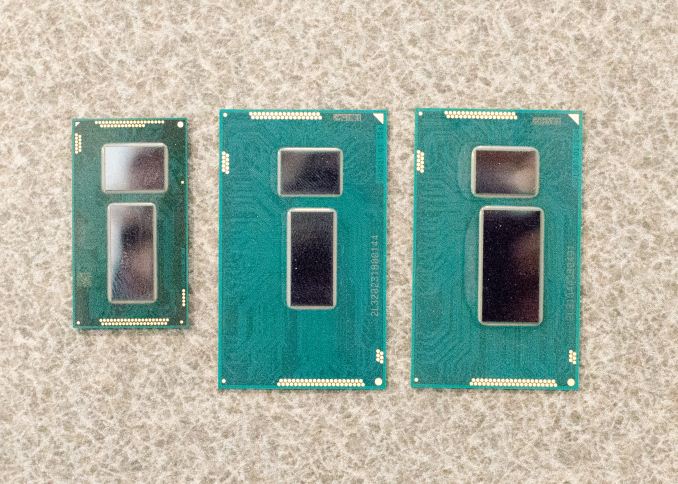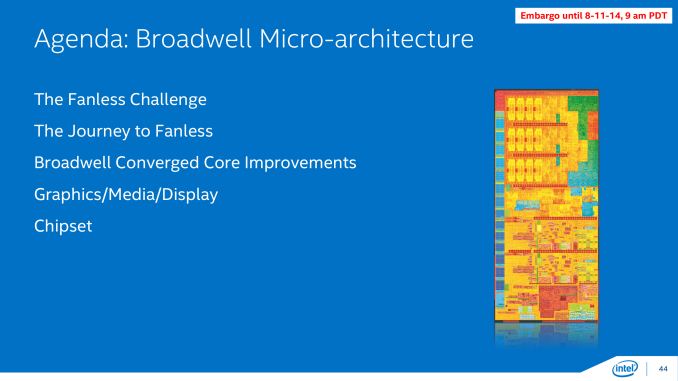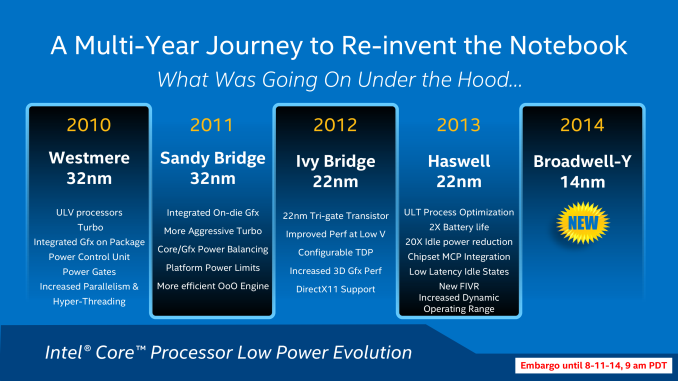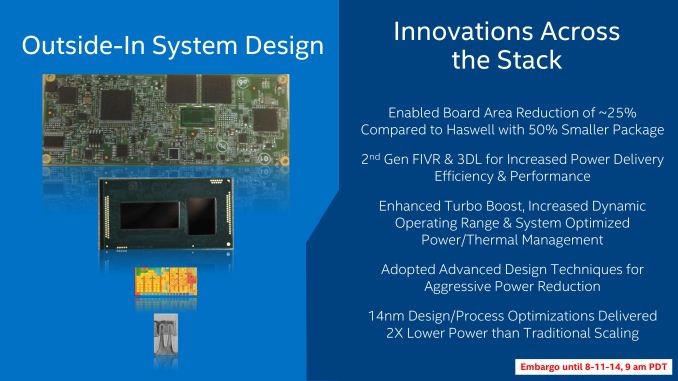Intel Broadwell Architecture Preview: A Glimpse into Core M
by Ryan Smith on August 11, 2014 12:01 PM EST
With Haswell Refresh fully behind us and 2014 now in to its second half, Intel is turning their attention to their next generation of products and processes. Intel’s tick-tock methodology coupled with the long development periods of new products means that the company has several projects in flight at any given time. So while we have seen the name Broadwell on Intel’s roadmaps for some time now, the reality of the situation is that we know relatively little about Intel’s next generation architecture and the 14nm process that it is the launch vehicle for.
Typically we would see Intel unveil the bulk of the technical details of their forthcoming products at their annual Intel Developer Forum, and with the next IDF scheduled for the week of September 9th we’ll see just that. However today Intel will be breaking from their established standards a bit by not waiting until IDF to deliver everything at once. In a presentation coinciding with today’s embargo, dubbed Advancing Moore’s Law in 2014, Intel will be offering a preview of sorts for Broadwell while detailing their 14nm process.
Today’s preview and Intel’s associated presentation are going to be based around the forthcoming Intel Core M microprocessor, using the Broadwell configuration otherwise known at Broadwell-Y. The reason for this is a culmination of several factors, and in all honesty it’s probably driven as much by investor relations as it is consumer/enthusiast relations, as Intel would like to convince consumer and investor alike that they are on the right path to take control of the mobile/tablet market through superior products, superior technology, and superior manufacturing. Hence today’s preview will be focused on the part and the market Intel feels is the most competitive and most at risk for the next cycle: the mobile market that Core M will be competing in.
To that end Intel’s preview is very much a preview; we will see bits and pieces of Broadwell’s CPU architecture, GPU architecture, and packaging, along with information about Intel’s 14nm process. However this isn’t a full architecture preview or a full process breakdown. Both of those will have to wait for Intel’s usual forum of IDF.
Diving into matters then, Core M will be launch vehicle for Broadwell and will be released for the holiday period this year. In fact Intel is already in volume production of the Broadwell-Y CPU and production units are shipping to Intel’s customers (the OEMs) to begin production and stockpiling of finished devices for the holiday launch.
Intel’s decision to initially focus Broadwell on the mobile market comes as the company takes the next step in their plan to extend into the Core processor series into these devices. Arguably, Intel has been slow to response to the rise of ARM devices, whose rapid rise has undercut traditional PC sales and quickly become the biggest threat to Intel’s processor dominance in some number of years. Intel is far from doomed right now, but even they see the potential farther down the line if they do not act.
Intel for their part has responded, but it has taken a step-by-step (multi-year) process that has seen the company progressively build smaller and less power hungry CPUs in order to fit the needs of the mobile market. Since Intel integrated their graphics on-die with Sandy Bridge in 2011, the company has continued to tweak the designs of their products, with Ivy Bridge and Haswell generation products introducing further optimizations and new manufacturing processes. Now on their latest iteration with Broadwell, the company believes they’re turning a corner and have the technology they need to be a leader in the high performance mobile market. It's important to note that despite Intel's best intentions here, Broadwell and Core M remain targeted at premium devices. You won't see these parts in cheap tablets. The duty of doing battle with ARM remains Atom's alone.
Many of these changes ultimately amount to boosting performance and reducing power consumption to a point where power and heat are where they need to be for mobile form factors, either through process efficiency improvements or through better power management and wider dynamic ranges – boosting where it matters and doing a better job of idling between tasks. However as Intel has discovered they not only need to be able to meet the TDP requirements of a tablet but they need to be able to meet the size requirements too. A particularly daunting task when the entire thickness of a device needs to be under 10mm, and the CPU thinner yet.
As a result, coupled with Core M’s performance improvements and power reductions is a strong emphasis on the size of the processor package itself and what Intel could do to reduce it. Intel calls this an outside-in system design, with various parts of Intel focusing on everything from the size of the logic board needed to hold the processor to the thickness of the processor die itself. In the following pages we’ll take a look at Intel’s efforts to get slim, but to kick things off we have a picture of Broadwell-Y from Computex 2014.

From left to right: Broadwell-Y (Core M), Broadwell ULT/ULX and Haswell ULT/ULX
Intel wants a greater foothold in the mobile market and they want it badly. And with Broadwell-Y they believe they finally have what they need to accomplish that goal.














158 Comments
View All Comments
D. Lister - Saturday, August 30, 2014 - link
So you must be feeling pretty darn stupid now, realizing that you never had to buy the more expensive 3770K (plus the gtx680), since from your point of view it "feels" the same as an 8350 or an 8320 with an HD5850... eh? Here's an idea, sell your 3770K/GTX680 system, and buy an FX8320/HD5850... you would still get some of your money back - if you can't do that, then at least just shut the hell up and stop deliberately spreading misinformation, you unethical hypocrite.wintermute000 - Tuesday, August 12, 2014 - link
"well, an fx-8350 is toe-to-toe with an i7-2600k"You lost all credibility right there
wurizen - Tuesday, August 12, 2014 - link
no ididn't. u wish.wurizen - Tuesday, August 12, 2014 - link
u mean the credibility of anonymous internet opinions?rkrb79 - Tuesday, November 18, 2014 - link
Everyone can have their own opinions. Leave wurizen alone. Heaven forbid someone say something you don't agree with. Put on your big boy pants intel fanboys.tomsworkshop - Thursday, August 14, 2014 - link
Global Foundries was AMD spunoff fab, AMD still holding share on Global Foundries, Global Foundries are working tightly with Samsung fab right now for better manufacturing process, when they reach their goal in nm race they can compete with Intel in die shrink.FstEddie - Thursday, August 14, 2014 - link
Actually StevoLincolnite and others, you are quite confused. Using larger node sizes is not "cheaper to produce". Larger node sizes are more expensive per chip. The reason AMD (global foundries) does not just jump down to the next node is that it requires a great deal of capital up front (they are relatively broke) and R@D time which they are already behind on. Intel has proven more adept at shrinking process nodes and invests more in R&D ahead of time. This allows Intel to use the new node budget to partially increase performance, partially decrease power and partially decrease cost/chip. Cost per chip is the main driver for increasing density and depending on the generation Intel has re-balanced the performance/power/cost relationship.Samus - Wednesday, August 13, 2014 - link
I love what they did with the Z-height by embedding the chip "through" the motherboard PCB. That's really smart and will definitely improve thickness.beggerking@yahoo.com - Monday, August 11, 2014 - link
this looks to be very interesting... a true gaming windows 8.1/9 tablet laptop convertible in Surface Pro 3 form factor.A5 - Monday, August 11, 2014 - link
I'd hesitate to say that this will enable any kind of "real" gaming in the traditional sense. The iGPU isn't strong enough in this form factor, and AMD/NV draw too much power.